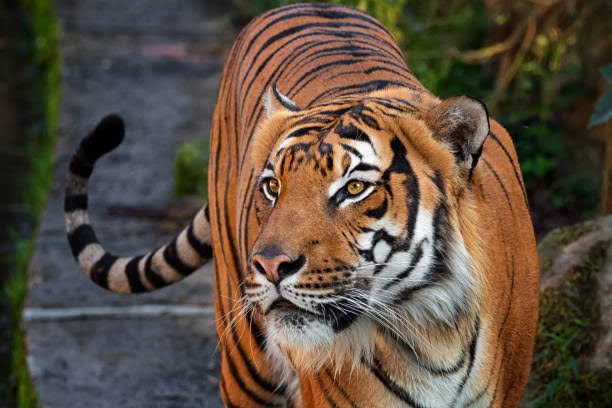Overview
The tiger (Panthera tigris) is the largest living cat species and a member of the genus Panthera. It is most recognizable for its dark vertical stripes on orange-brown fur with a lighter underside. It is an apex predator, primarily preying on ungulates such as deer and wild boar. It is territorial and generally a solitary but social predator, requiring large contiguous areas of habitat, which support its requirements for prey and rearing of its offspring. Tiger cubs stay with their mother for about two years, before they become independent and leave their mother’s home range to establish their own. The tiger has nine subspecies. Three of these are already extinct.
Types Of Tiger
1. Siberian Tiger

Also known as the Amur tiger, the Siberian tiger resides in a small region in the southeast region Russia. They are also located in small numbers in China and North Korea. It averages about 3.3 m (11 ft.) in length, with a tail measuring 1 m (3 ft.). Adult male Siberian tigers can weigh up to 320 kg (700 lb.), while females are significantly smaller, weighing up to 180 kg (400 lb.).
Siberian tigers are muscular, packed with large heads and powerful forelimbs. Their colors vary from orange to brown that are splashed with white areas and black stripes. Their faces have long whiskers that are longer in male tigers, featuring eyes that don rounded pupils that have been accentuated by yellow irises. The ears, however, are small and rounded with black markings that surround white areas called ocelli.
2. Bengal Tiger

The Bengal tiger is a tiger from a specific population of the Panthera tigris tigris subspecies. It ranks among the biggest wild cats alive today. Bengal tigers can be found in alluvial grasslands, rainforests of both the tropical and subtropical kinds, mangroves, deciduous forests and scrub forests.
The Bengal tiger’s coat is yellow to light orange, with stripes ranging from dark brown to black; the belly and the interior parts of the limbs are white, and the tail is orange with black rings. Male Bengal tigers can reach up to 270 to 310 centimeters (110 to 120 inches) while the females reach up to 240 to 265 centimeters (94 to 104 inches). The males are also heavier, at 175 to 260 kilograms (390 to 570 pounds), while the females weigh around 100 to 181 kilograms (220 to 400 pounds).
Also Read: Hybrid Animals
3. Indochinese Tiger

Indochinese tigers are a tiger subspecies, inhabiting of Southeastern Asia, across Myanmar, Cambodia, Laos, Thailand, and Vietnam. Their numbers are dwindling in most of their range, except for Thailand, where their population is said to be higher. This subspecies is smaller than the Bengal and Siberian tigers, but larger than the Sumatran and Malayan tiger.
The Indochinese tiger’s skull is smaller than that of the Bengal tiger; the ground coloration is darker with more rather short and narrow single stripes. In body size, it is smaller than Bengal and Siberian tigers. Males range in size from 255 to 285 cm (100 to 112 in) and in weight from 150 to 195 kg (331 to 430 lb). Females range in size from 230 to 255 cm (91 to 100 in) and in weight from 100 to 130 kg (220 to 290 lb).
Indochinese tigers prefer to live in forests in areas that are either hilly or mountainous. There aren’t a lot of these tigers anymore. This type of tiger has been listed as endangered on the IUCN Red List since 2008, as the population seriously declined and approaches the threshold for critically endangered.
4. Malayan Tiger

Malayan tiger is one of the smallest subspecies of tiger. It can be found in Malaysia (hence the name) and southern parts of Thailand. Malayan tiger gained status of subspecies recently, in 2004. Before that time, researchers thought that Malayan tiger and Indochinese tiger are the same (genetic analysis revealed differences between these two types of tiger).
There is no clear difference between the Malayan and the Indochinese tigers, when specimens from the two regions are compared cranially or in pelage. Malayan tigers appear to be smaller than Bengal tigers, the average length of a male is 8 ft 6 in (259 cm), and of a female 7 ft 10 in (239 cm). Body length of female tigers ranges from 70 to 103 in (180 to 260 cm). Their height ranges from 23 to 41 in (58 to 104 cm), and their body weight from 52 to 195 lb (24 to 88 kg).
Malayan tiger inhabits dense tropical jungles and areas near the rivers. The greatest threats for the survival of Malayan tiger in the wild are illegal hunting (tiger’s bones are used in traditional Asian medicine), conflicts with humans, lack of prey and habitat destruction. Malayan tiger is critically endangered subspecies of tiger with only 250 to 340 animals left in the wild.
5. South China Tiger

The South China Tiger is known by many names, including the Amoy Tiger, Chinese Tiger and Xiamen Tiger. However, its official scientific name is Panthera tigris amoyensis. The stripes of this subspecies are particularly broad, but they are also spaced further apart than in other tigers. This gives the coat a striking, impressive appearance.
The South China tiger belongs to a group of smaller tiger subspecies, with lengths spanning from 2.2 to 2.6 meters (87 to 100 inches). The range of the length of South China tigers is true for both male and female tigers. Males have a weight range of 127 to 177 kg (280 to 390 pounds); females, on the other hand, have a weight range of 100 to 118 kilograms (220 to 260 pounds).
South China Tiger is generally categorized as critically endangered species. In this regard, there are conservation efforts supporting sustainable management of tiger habitat, stronger protections of the tigers in those habitats, and development programs for the communities that live nearby, so that no one feels forced to turn to poaching to feed their families.
6. Sumatran Tiger

The Sumatran tiger is a subspecies of tiger native to the Indonesian island of Sumatra. It’s the smallest of the tigers, possibly because it evolved on an isolated island habitat. The Sumatran tiger’s stripes are closer together and its fur is a darker orange than other subspecies, better allowing it to blend into its tropical rainforest habitat.
Males usually weigh 200 to 300 pounds, and females weigh 180–300 pounds. Healthy tigers have very little body fat, so that mass is almost entirely bone and muscle. Sumatran tigers may be 9 to 12 feet long, including the tail.
Habitat for the Sumatran tiger has been drastically reduced by clearing for agriculture (particularly oil palm), plantations, and settlement. On many parts of the island, illegal timber harvesting, and forest conversion are out of control. Many of the remaining Sumatran tigers live in protected areas, such as national parks. Park rangers’ anti-poaching patrols give them an extra layer of protection.
Extinct Species
7. Caspian Tiger

The Panthera tigris virgata is better known as the Caspian tiger as well as under other names, such as the Hyrcanian or the Turan tiger. This tiger subspecies used to be found in sparse forests. It was also found south and west of the Caspian Sea. At least, it wast still sighted in the wild up to the early 1970s. The closest living subspecies to the Caspian tiger is the Amur tiger.
Also Read: Caterpillars With Stripes
8. Javan Tiger

The Panthera tigris sondaica, otherwise known as the Javan tiger, used to live only on the island that it was named after. Sightings have been recorded up to the middle part of the 1970s. The tigers in these subspecies are bigger than Bali tigers, with the males weighing 100 to 140 kilograms (220 to 310 pounds) and the females weighing 75 to 115 kilograms (170 to 250 pounds). Sadly, the Javan tiger has no longer been sighted after 1979 when it was last seen around the Mount Betiri area.
During a Mount Halimun Salak National Park expedition back in 1990, there was no definite evidence to support that there are still living Javan tigers.
9. Bali Tiger

Some tiger subspecies may still be mentioned in books but they have already been extinct as habitats continue to be destroyed. The Panthera tigris balica, which is popularly known as the Bali tiger, used to be limited to Bali, which is an Indonesian island. When it still existed, the Bali tiger was the smallest tiger subspecies, with the males weighing 90 to 100 kilograms (200 to 220 pounds) and the females weighing 65 to 80 kilograms (140 to 180 pounds). It is unfortunate that people can no longer appreciate the beauty of a Bali tiger in its compact size. The tigers have become extinct because of hunting. The last of its kind, which is an adult female, was believed to have been hunted and killed in Sumbar Kima.
Further References
- Where do Tigers live?: https://www.worldwildlife.org/stories/where-do-tigers-live-and-other-tiger-facts
- Facts About Tiger: https://www.worldwildlife.org/species/tiger
- Types of Tigers: https://storyteller.travel/types-of-tigers/
- Tiger Species And What You Need Know: https://en.m.wikipedia.org/wiki/Tiger
- Information About Tigers: http://www.lions.org/types-of-tigers.html